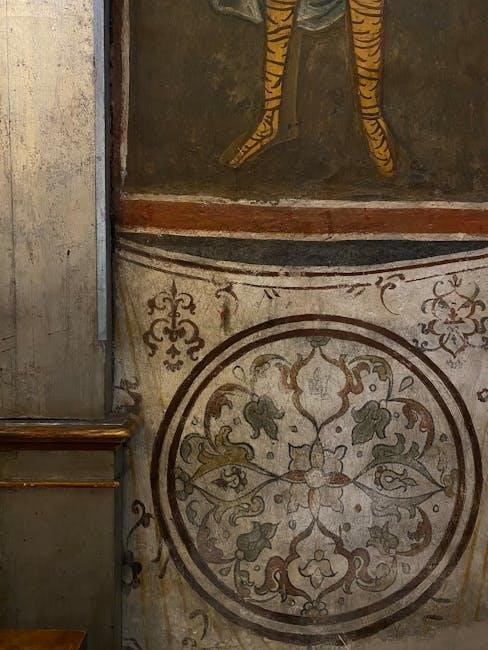Restorative circle questions promote social emotional learning and community building, using a circle process to facilitate discussions and activities, with guidelines and norms for participation, as seen in restorative circle questions pdf resources online today easily.
Overview of Restorative Circles
Restorative circles are a powerful tool for building community and promoting social emotional learning, as outlined in various restorative circle questions pdf resources.
They provide a safe and structured space for individuals to share their thoughts, feelings, and experiences, and to listen to and learn from others.
The circle process is designed to foster empathy, understanding, and connection among participants, and to help build stronger, more positive relationships.
Restorative circles can be used in a variety of settings, including schools, communities, and workplaces, and can be adapted to meet the needs of different groups and populations.
They are often used to address conflicts, build trust, and promote healing and restoration, and can be a valuable addition to any community or organization.
By providing a safe and supportive space for individuals to share their thoughts and feelings, restorative circles can help to build stronger, more positive relationships and promote social emotional learning.
The use of restorative circles is becoming increasingly popular, and many organizations and communities are turning to this approach as a way to build stronger, more positive relationships and promote social emotional learning.
Restorative circles are a valuable tool for building community and promoting social emotional learning, and can be a powerful way to foster empathy, understanding, and connection among individuals.
They offer a unique and effective approach to building stronger, more positive relationships, and can be adapted to meet the needs of different groups and populations.
Overall, restorative circles are a valuable resource for anyone looking to build stronger, more positive relationships and promote social emotional learning.

Benefits of Restorative Circle Questions
Restorative circle questions promote empathy, understanding, and connection, fostering positive relationships and social emotional learning, as seen in restorative circle questions pdf resources, enhancing community and communication skills effectively always online.
Building Trust and Connection
Restorative circle questions play a crucial role in building trust and connection among individuals, as seen in restorative circle questions pdf resources online.
These questions help to create a safe and supportive environment where people feel comfortable sharing their thoughts and feelings.

By using restorative circle questions, individuals can develop a deeper understanding of each other and foster positive relationships.
This is achieved through active listening, empathy, and open communication, which are essential components of restorative circle questions.
The process of building trust and connection is ongoing and requires effort and commitment from all parties involved.
Restorative circle questions provide a framework for this process, allowing individuals to work together to build stronger, more meaningful relationships.
The benefits of building trust and connection are numerous, including improved communication, increased empathy, and a stronger sense of community.
By incorporating restorative circle questions into daily life, individuals can experience these benefits and develop more positive and supportive relationships.
Overall, restorative circle questions are a valuable tool for building trust and connection, and can be used in a variety of settings, including personal and professional relationships.
The use of restorative circle questions can have a profound impact on individuals and communities, leading to greater understanding, empathy, and connection.
This is evident in the many restorative circle questions pdf resources available online, which provide guidance and support for individuals looking to build trust and connection.
Restorative circle questions are an effective way to build trust and connection, and can be used by anyone looking to improve their relationships and communication skills.
The process is simple, yet powerful, and can have a lasting impact on individuals and communities.
By using restorative circle questions, individuals can take the first step towards building stronger, more meaningful relationships, and creating a more supportive and connected community.
This can lead to a more positive and productive environment, where individuals feel valued and supported.
The benefits of restorative circle questions are clear, and their use can have a significant impact on individuals and communities.
Restorative circle questions are a valuable resource for anyone looking to build trust and connection, and can be used in a variety of settings.
The use of restorative circle questions can help to create a more positive and supportive environment, where individuals can thrive and grow.
This is achieved through the use of open-ended questions, which encourage active listening and empathy.
The benefits of restorative circle questions are numerous, and their use can have a lasting impact on individuals and communities.
Overall, restorative circle questions are a powerful tool for building trust and connection, and can be used by anyone looking to improve their relationships and communication skills.
The process is simple, yet effective, and can lead to a more positive and productive environment.
Restorative circle questions are an essential component of building trust and connection, and can be used in a variety of settings.
The use of restorative circle questions can help to create a more supportive and connected community, where individuals feel valued and supported.
This can lead to a more positive and productive environment, where individuals can thrive and grow.
The benefits of restorative circle questions are clear, and their use can have a significant impact on individuals and communities.
Restorative circle questions are a valuable resource for anyone looking to build trust and connection, and can be used by anyone looking to improve their relationships and communication skills.
The process is ongoing, and requires effort and commitment from all parties involved.
The use of restorative circle questions can help to create a more positive and supportive environment, where individuals can build stronger, more meaningful relationships.
This is achieved through the use of open-ended questions, which encourage active listening and empathy.
The benefits of restorative circle questions are numerous, and their use can have a lasting impact on individuals and communities.
Overall, restorative circle questions are a powerful tool for building trust and connection, and can be used in a variety of settings.
The process is simple, yet effective, and can lead to a more positive and productive environment, where individuals can thrive and grow.

Types of Restorative Circle Questions
Open-ended questions and check-in rounds are types of restorative circle questions, found in restorative circle questions pdf, used to encourage sharing and listening in a supportive community environment always online.
Open-Ended Questions
Open-ended questions are a key component of restorative circle questions, as they encourage participants to share their thoughts and feelings in a meaningful way, promoting deeper understanding and connection among group members. These types of questions are often used in restorative circle questions pdf resources, which provide guidance on how to facilitate restorative circles and promote social emotional learning. Open-ended questions are designed to be thought-provoking and allow participants to reflect on their experiences and emotions, helping to build trust and empathy within the group. By using open-ended questions, facilitators can create a safe and supportive environment where participants feel comfortable sharing their perspectives and listening to others. This can lead to increased empathy, understanding, and community building, which are essential goals of restorative circles. Additionally, open-ended questions can help to foster critical thinking and problem-solving skills, as participants are encouraged to think deeply about the topics being discussed. Overall, open-ended questions are a valuable tool in restorative circles, and can be used to promote positive relationships and a sense of community; They are widely used in restorative circle questions pdf and other resources.

Using Restorative Circle Questions in Practice
Facilitators use restorative circle questions pdf to create a supportive environment, promoting social emotional learning and community building through effective facilitation techniques and strategies online every day with great success always.
Facilitating a Restorative Circle
Facilitating a restorative circle requires careful planning and execution to ensure a positive and productive experience for all participants. The goal of a restorative circle is to create a safe and supportive environment where individuals can share their thoughts and feelings, and work together to build stronger relationships and resolve conflicts. To achieve this, facilitators must be aware of the importance of creating a comfortable and inclusive space, and be skilled in using restorative circle questions pdf to guide the discussion and keep the conversation focused. A key aspect of facilitating a restorative circle is establishing clear guidelines and norms for participation, such as active listening and respect for others’ opinions. By doing so, facilitators can help participants feel more at ease and encourage open and honest communication. Additionally, facilitators must be able to manage the dynamics of the circle, ensuring that all participants have an opportunity to contribute and that the discussion remains productive and respectful; With effective facilitation, restorative circles can be a powerful tool for building stronger, more compassionate communities. Effective facilitation techniques and strategies are essential for a successful restorative circle.
